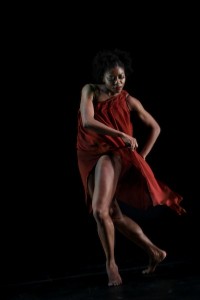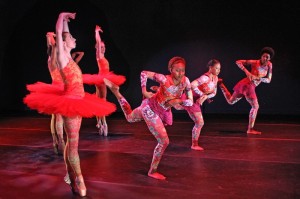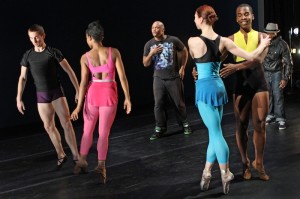Brooklyn Ballet’s 2012 season, “Revolutionaries and Romantics” is currently underway, and it includes a performance at the Kumble Theater today, Friday, April 13th. We corresponded with Artistic Director Lynn Parkerson about live music, different dance styles and more. Here’s a behind-the-scenes peek…

The project started with a conversation with Kumble Theater Director, Rodney Hurley. He wondered what kind of program Brooklyn Ballet would create to illuminate major influences in classical ballet at the turn of the century ca.1890-1920. My first thought was Isadora Duncan and the Russian ballet. Research suggests that Isadora had a profound influence on classical ballet. Michel Fokine, Anna Pavlova, Sergei Diaghilev were all mad about her performances. I was curious about the structural and artistic ideas of both Duncan and Fokine and sought to interweave Duncan’s Chopin Waltzes and Fokine’s Les Sylphides. I found wonderful similarities and harmonious contrasts, a dance of great ghosts. She is the Revolutionary, he is the Romantic. Her courage gave life to his romantic ideas heretofore suppressed by the constraints of the Russian Imperial Theater. There are other tie-ins to the theme. Isadora’s own work plums the depths of love and her Chopin Dances are all about romantic love. Isadora’s powerful Revolutionary Etude, one of her last works, expresses like no other work the spirit of Revolution.

I like the way different dance styles connect with each other even though they are seemingly quite different. I like to find connections, then expand on them as opposed to fusing two styles. For example, when I add three African-based modern dancers to The Marzipan Dance from The Nutcracker, the dancers remain in separate opposing diagonals, the choreography of the ballet dancers, spiky, light and vertical, the choreography of the modern dancers low-slung, lateral, weighted. They dance in unison nonetheless, a rhythmically-related flirt fest!
I’ve also been working with pop and lock dancers since 2005, collaborating primarily with Michael “Mike Supreme” Fields. In this season our departure point was Stravinsky’s “Suite Italienne.” What is so interesting is how the “pop and lock” dancers respond to the Stravinsky in such a directly personal way. The ballet dancers, on the other hand, have step material through which the music is interpreted more abstractly. Still, when performed all together the dancers are characters on the stage, relating to each other in their given forms. The ballet dancers are at times improvising and the “pop and lock” dancers are choreographing. Both sets of dancers are exploring new territories.

A whole world, of human interaction, of sound coming from human hands on acoustic instruments. The musicians–violinist Gil Morgenstern, director of The Reflection Series, and pianist Julius Abrahams–are world class. Their music soars and gives the dancers such a ground to dance on and an energy that changes from minute to minute, is slightly unpredictable, that forces the dancers to interact.
What is next for Brooklyn Ballet?
Next season I’d like to create a work that uses digital technology to map out floor patterns of the dancers in real time. I want to reveal the conscious use of space that I and all choreographers use as we create. Choreographers don’t take space for granted. I want to let the audience in on this. Music choices will include Harpsichord works by Louis and Francois Couperin. It is also Brooklyn Ballet’s 10th year anniversary so we’ll be celebrating our education and outreach programs as well.
BIO: Lynn Parkerson, Founding Artistic Director of Brooklyn Ballet, began ballet studies as a child with Barbara Bounds in Chapel Hill, NC. She later danced with the Boston and Chicago Ballets, performing many Nutcrackers and Balanchine ballets. In New York City, she was a trainee at the Harkness House for Ballet Arts and on scholarship at the Merce Cunningham School, where she studied technique and learned repertory. In addition, she trained in the Limón Technique with Libby Nye and ballet with the Corvinos. From 1986 to 1996, she performed the repertory of Isadora Duncan as interpreted by Hortense Koulouris and Julia Levien.
Ms. Parkerson began to choreograph while living in Munich, Germany, dancing with Birgitta Trommler’s TanzProject Munchen. Her work has been presented at many promi- nent international events and venues, including the Munich Theater Festival, Frankfurt’s Theatre am Turm, the Florence International Festival of Dance, Moers New Jazz Festival, Jazz Festival Baden-Baden and An Appalachian Summer Arts Festival in Boone, NC, among others. In New York City, she presented annual dance programs—notably the popular ballet series To the Pointe—as Director of Dance at Holy Trin- ity from 1991-2001. Her work has been supported by grants from the Harkness Foundation for Dance, Joyce Mertz-Gilm- ore Foundation and Con Edison. She was on the faculty at the 92nd Street Y Harkness Dance Center from 1989-1996 and then served as its Assistant Director from 1996-1999. Ms. Parkerson has taught dance, improvisation, and choreogra- phy to children and adults in New York and abroad.
In recognition of her exceptional leadership contributions to Brooklyn’s cultural community, Ms. Parkerson received the Betty Smith Arts Award as part of the Women’s “Her- story” Induction Ceremony and Reception in 2007. Each year, the awards, named after some of the most outstand- ing women in Brooklyn “herstory,” are presented to six Brooklyn women. In 2006 she received the Paul Robeson Award for Artistic Excellence and Community Service.




